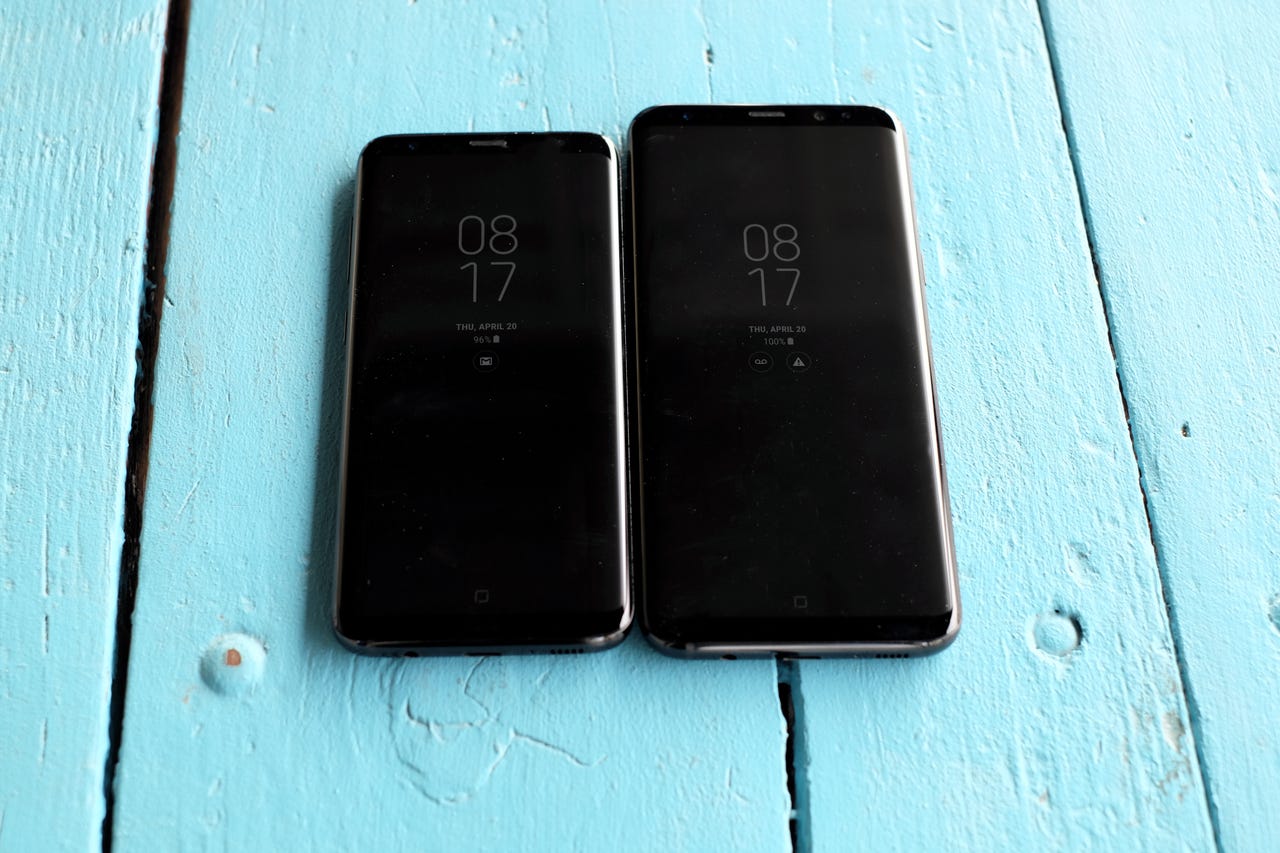Sizing up the Samsung Galaxy S8, S8 Plus against the competition, in pictures


Galaxy S8 vs Galaxy S8 Plus
A byproduct of shrinking down the bezels around a smartphone's screen is a larger screen in a smaller housing.
The Samsung Galaxy S8 (pictured left) and the Galaxy S8 Plus (pictured right) have a 5.8-inch and 6.2-inch display, respectively.
As you can see, the S8 Plus is ever so slightly bigger than the smaller offering.
Click through the rest of the gallery to see the S8 and S8 Plus compared to seven different devices.
If we don't have a device you wanted to see the S8 compared to, this website does a fanstastic job at giving you quick comparisons.
Galaxy S8 vs Galaxy S8 Plus
Another shot of the Galaxy S8 and Galaxy S8 Plus.
The S8 is slightly thinner and shorter than its bigger brother.
Galaxy S8 vs Galaxy S7 Edge
Last year's Galaxy S7 Edge has a 5.5-inch display.
From this photo, it's clear the S8 is narrower than the S7 Edge.
Galaxy S8 vs Galaxy S7 Edge
Until you place the S8 on top of the S7 Edge, however, you don't realize just how much easier it is to hold thanks to the narrow frame.
Galaxy S8 vs iPhone 7
The standard iPhone 7 has a 4.7-inch display, and it's only slightly smaller than the standard Galaxy S8.
Galaxy S8 vs iPhone 7
The iPhone 7 and S8 are nearly identical in width, with the added screen size making the S8 just a tad taller.
Galaxy S8 vs iPhone 7 Plus
Putting the S8 next to the iPhone 7 Plus shows just how much wasted space there is on Apple's iPhones.
Not only is the S8's display larger, the phone is drastically smaller.
Galaxy S8 vs iPhone 7 Plus
Look at the difference! Remember, the iPhone 7 Plus has a 5.5-inch display and it's gigantic in comparison.
Galaxy S8 vs LG G6
The LG G6 is closer in size to the Galaxy S8 due to the company also shrinking down the bezels.
The G6's display is 5.7 inches, yet it's slightly taller than the S8.
Galaxy S8 vs LG G6
As is the case nearly across the board, the S8 is also narrower than the G6.
Galaxy S8 vs Nexus 5X
Google's Nexus 5X has a 5.2-inch display, yet the S8 is the same height with its 5.8-inch display.
Galaxy S8 vs Nexus 5X
And, of course, the S8 is skinner than the 5X.
Galaxy S8 vs Nexus 6P
The 6-inch display on the Nexus 6P looks even bigger when put next to the S8.
Galaxy S8 vs Nexus 6P
Users of the Nexus 6P learned to manage the larger device, but after seeing it next to the S8, I'm not sure how.
Galaxy S8 vs Google Pixel XL
Google's flagship device, the Pixel XL has 5.5-inch display, but due to the top and bottom bezels, it looks a lot bigger.
Galaxy S8 vs Google Pixel XL
Do you ever want to use a phone with bezels again?
In addition to removing the screen's border, the Galaxy S8 lineup also benefited by Samsung's switch to a 18.5:9 screen ratio.
The longer screen is slimmer by nature.
Galaxy S8 Plus vs Galaxy S7 Edge
The S8 Plus has a 6.2-inch display and dwarfs the S7 Edge's 5.5-inch screen.
Galaxy S8 Plus vs Galaxy S7 Edge
But, as you may have guessed, the device itself isn't that much bigger than the S7 Edge.
Galaxy S8 Plus vs iPhone 7
The S8 Plus compared to the standard iPhone 7 makes the iPhone look like the iPhone SE.
Galaxy S8 Plus vs iPhone 7
The screen of the S8 Plus is almost as big, if not bigger, than the entire footprint of the iPhone 7.
Galaxy S8 Plus vs iPhone 7 Plus
So much wasted space above and below the display on the iPhone 7 Plus.
Doesn't the 7 Plus just look old now? Like, really old?
Galaxy S8 Plus vs iPhone 7 Plus
Practically the same height as the iPhone 7 Plus, the S8 is a tad skinnier, too.
Galaxy S8 Plus vs LG G6
LG's G6 is a solid device all around, but Samsung sure did out design its Korean rival.
Galaxy S8 Plus vs LG G6
The S8 Plus is barely taller than the LG G6.
Galaxy S8 Plus vs Nexus 5X
It continues to boggle my mind that Samsung made a smartphone with a 6.2-inch display that's only slightly larger than the Nexus 5X.
Galaxy S8 Plus vs Nexus 5X
Again, nearly identical width and only a little taller.
Galaxy S8 Plus vs Nexus 6P
The only benefit the Nexus 6P has over the S8 Plus is that the fingerprint sensor is much easier to reach and not next to the camera lens (as it is on Samsung's phone).
Galaxy S8 Plus vs Nexus 6P
Which device would you rather hold?
Galaxy S8 Plus vs Google Pixel XL
The Pixel XL, released just a few months ago, looks like a device from 2015.
Samsung really outdid itself this time.
Galaxy S8 Plus vs Google Pixel XL
The S8 Plus is a little taller, but once again narrower, than the Pixel XL.